Life Processes Class 10 MCQs Questions with Answers
Life Processes Class 10 MCQ Question 1.
If salivary amylase is lacking in the saliva, which of the following events in the mouth cavity wilL be affected?
(a) Proteins breaking down into amino acids
(b) Starch breaking down into sugars
(c) Fats breaking down into fatty acids and glycerol
(d) Absorption of vitamins
Answer:
(b) Starch breaking down into sugars
Explanation: The process of digestion begins in the mouth. The mouth contains a digestive enzyme, salivary amylase. This enzyme breaks the starch molecules in the food, into maltose. The absence of amylase in the saliva thus affects the breakdown of starch into simpler sugar molecules.
Class 10 Life Processes MCQ Question 2.
In the excretory system of human beings, some substances in the initial filtrate such as glucose, amino acids, salts and water are selectively reabsorbed in:
(a) Urethra
(b) Nephron
(c) Ureter
(d) Urinary bladder
Answer:
(b) Nephron.
Explanation: A nephron is a filtering unit present in kidney. It has different parts like Bowman’s capsule, glomerulus and tubuLar region (Renal tubule). Glucose, amino acids and salts are selectively reabsorbed in tubular region.
![]()
Life Processes MCQ Class 10 Question 3.
Which part of alimentary canal receives bile from the liver?
(a) Stomach
(b) Small intestine
(c) Large intestine
(d) Oesophagus
Answer:
(b) Small intestine
Explanation: Bile is secreted by the liver and is stored in the gall bladder from where it enters the small intestine via a common duct.
Related Theory
It performs two functions:
- makes the food alkaline.
- breaks the fats present in food into small globules by the process of emulsification.
MCQ On Life Processes Class 10 Question 4.
Pseudopodia are:
(a) small hair-like structures present on unicellular organisms.
(b) false feet developed in some unicellular organisms.
(c) long, tube-like structures coming out of the mouth.
(d) suckers which are attached to the walls of the intestines.
Answer:
Class 10 Science Chapter 6 MCQ Question 5.
A few drops of iodine solution were added to rice water. The solution turned blue-black in colour. This indicates that the rice water contains:
(a) Complex proteins
(b) Simple proteins
(c) Fats
(d) Starch
Answer:
(d) Starch
Explanation: Iodine solution is often used for testing the presence of starch in the food particles. When iodine is added to starch, it turns blue-black. Rice water contains starch, hence when iodine solution is added to rice water it turns blue-black.
![]()
MCQ Of Life Processes Class 10 Question 6.
which one of the following statements is correct about the human circulatory system?
(a) Blood transports only oxygen and not carbon dioxide.
(b) Human heart has five chambers.
(c) Valves ensure that the blood does not flow backwards.
(d) Both oxygen-rich and oxygen-deficient blood gets mixed in the heart.
Answer:
Class 10 Life Process MCQ Question 7.
Anaerobic process:
(a) takes place in yeast during fermentation.
(b) takes place in the presence of oxygen.
(c) produces only energy in the muscles of human beings.
(d) produces ethanol, oxygen and energy.
Answer:
(a) takes place in yeast during fermentation.
Explanation: (a) Anaerobic respiration (in absence of oxygen) in yeast is known as fermentation as ethanol (alcohol) carbon dioxide and 2 ATP molecules of energy is produced from glucose.
![]()
carbon dioxide + 2 ATP molecules of energy
(b) Aerobic respiration takes place in presence of oxygen and anaerobic in absence of oxygen.
(c) In muscles of human beings: Lack of oxygen or absence of oxygen results into the formation of lactic acid and very less amount of energy.
(d) Ethanol and carbon dioxide are produced. Energy is neither produced nor released.
MCQ Life Processes Class 10 Question 8.
When air is blown from mouth into a test tube containing Lime water, the lime water turns milky due to the presence of
(a) Oxygen
(b) Carbon dioxide
(c) Nitrogen
(d) Water vapour
Answer:
Ch 6 Science Class 10 MCQ Question 9.
Most of the digestion and absorption of the food takes place in the:
(a) small intestine
(b) liver
(c) stomach
(d) large intestine
Answer:
(a) small intestine.
Explanation: Small intestine receives juices from liver, pancreas and walls of small intestine. Bite juice from liver emulsifies the fats and makes the medium alkaline. Pancreas and small intestine juices contain amylase, lipase and tryspin.
The function of these enzymes ore:

Class 10 Science Ch 6 MCQ Question 10.
Which of the foL[owing statement (s) is (are) true about respiration?
(I) During inhalation ribs move inward and the diaphragm is raised.
(II) In the alveoli, the exchange of gases takes place i.e. oxygen from alveolar air diffuses into bLood and carbon dioxide from the blood into the alveolar air.
(III) Haemoglobin has a greater affinity for carbon dioxide than oxygen.
(IV)Atveoti increases surface area for the exchange of gases.
(a) (I) and (IV)
(b) (II) and (III)
(c) (I) and (III)
(d) (II) and (IV)
Answer:
Life Processes Class 10 MCQ With Answers Question 11.
Which is the correct sequence of air passage during inhalation?
(a) Nostrils → Larynx → Pharynx → Trachea → Lungs
(b) Nasal passage → Trachea → Pharynx → Larynx → Alveoli
(c) Larynx → Nostrils → Pharynx → Lungs
(d) Nostrils → Pharynx → Larynx → Trachea → Alveoli
Answer:
(d) Nostrils → Pharynx → Larynx → Trachea → Alveoli
![]()
Life Process Class 10 MCQ Question 12.
During respiration, the exchange of gases take place in:
(a) Trachea and Larynx
(b) Alveoli of lungs
(c) Alveoli and throat
(d) Throat and larynx
Answer:
MCQs Of Life Processes Class 10 Question 13.
Single circulation, i.e., blood flows through the heart only once during one cycle of passage through the body, is exhibited by:
(a) Labeo, Chameleon, Salamander
(b) Hippocampus, Exocoetus, Anabas
(c) Hyla, Rana, Draco
(d) whale, dolphin, turtle
Answer:
(b) Hippocampus, Exocoetus, Anabas
Explanation: Fishes have two-chambered heart and exhibit single circulation, while three-chambered heart of amphibians and reptiles and four-chambered heart of birds and mammals exhibit double circulation.
MCQs On Life Processes Class 10 Question 14.
In which of the following vertebrate group/ groups, does heart not pump oxygenated blood to different parts of the body?
(a) Pisces and amphibians
(b) Amphibians and reptiles
(c) Amphibians only
(d) Pisces only
Answer:
(d) Pisces only
Explanation: Fishes have only two-chambered heart and the blood is pumped to the gills, is oxygenated there, and passes directly to the rest of the body. Thus, blood goes only once through the heart in the fish during one cycle of passage through the body. Fishes take in water through their mouths and force it past the gills where the dissolved oxygen is taken up by blood.
Class 10 Science Life Process MCQ Question 15.
Which of the following statements about the autotrophs is incorrect:
(a) They synthesize carbohydrates from carbon dioxide and water in the presence of sunlight and chlorophyll
(b) They store carbohydrates in the form of starch
(c) They convert carbon dioxide and water into carbohydrates in the absence of sunlight
(d) They constitute the first trophic level in food chains
Answer:
(c) They convert carbon dioxide and water into carbohydrates in the absence of sunlight Explanation: Autotrophs obtain the required carbon and energy requirements from carbon dioxide and Sunlight. They combine carbon dioxide and water to form carbohydrates.
Question 16.
Oxygen liberated during photosynthesis comes from:
(a) Water
(b) Chlorophyll
(c) Carbon dioxide
(d) Glucose
Answer:
![]()
Question 17.
The blood leaving the tissues becomes richer in:
(a) Carbon dioxide
(b) Water
(c) Haemoglobin
(d) Oxygen
Answer:
(a) Carbon dioxide
Explanation: The blood leaving the tissues becomes richer in carbon dioxide. When the oxygenated blood passes through the capillaries of the tissue, it gives oxygen to the body cells and takes carbon dioxide, produced during cellular respiration. Thus, it becomes richer in carbon dioxide.
Question 18.
The xylem in plants are responsible for:
(a) Transport of water
(b) Transport of food
(c) Transport of amino acids
(d) Transport of oxygen
Answer:
(a) Transport of water
Explanation: Xylem tissues include tracheids, vessels, fibres and parenchyma and serve in the ascent of sap/water and minerals.
Related Theory
Phloem tissues comprised of four elements: sieve, companion cell, phloem fibres and phloem parenchyma. They serve in the translocation of organic nutrients.
Question 19.
Which of the following is an incorrect statement?
(a) Organisms grow with time.
(b) Organisms must repair and maintain their structure.
(c) Movement of molecules does not take place among cells.
(d) Energy is essential for life processes.
Answer:
Question 20.
The internal (cellular) energy reserve in autotrophs is:
(a) Glycogen
(b) Protein
(c) Starch
(d) Fatty acid
Answer:
(c) Starch
Explanation: The food prepared in the plant (autotrophs) by the process of photosynthesis is glucose that gets stored in various plant parts in the form of starch.
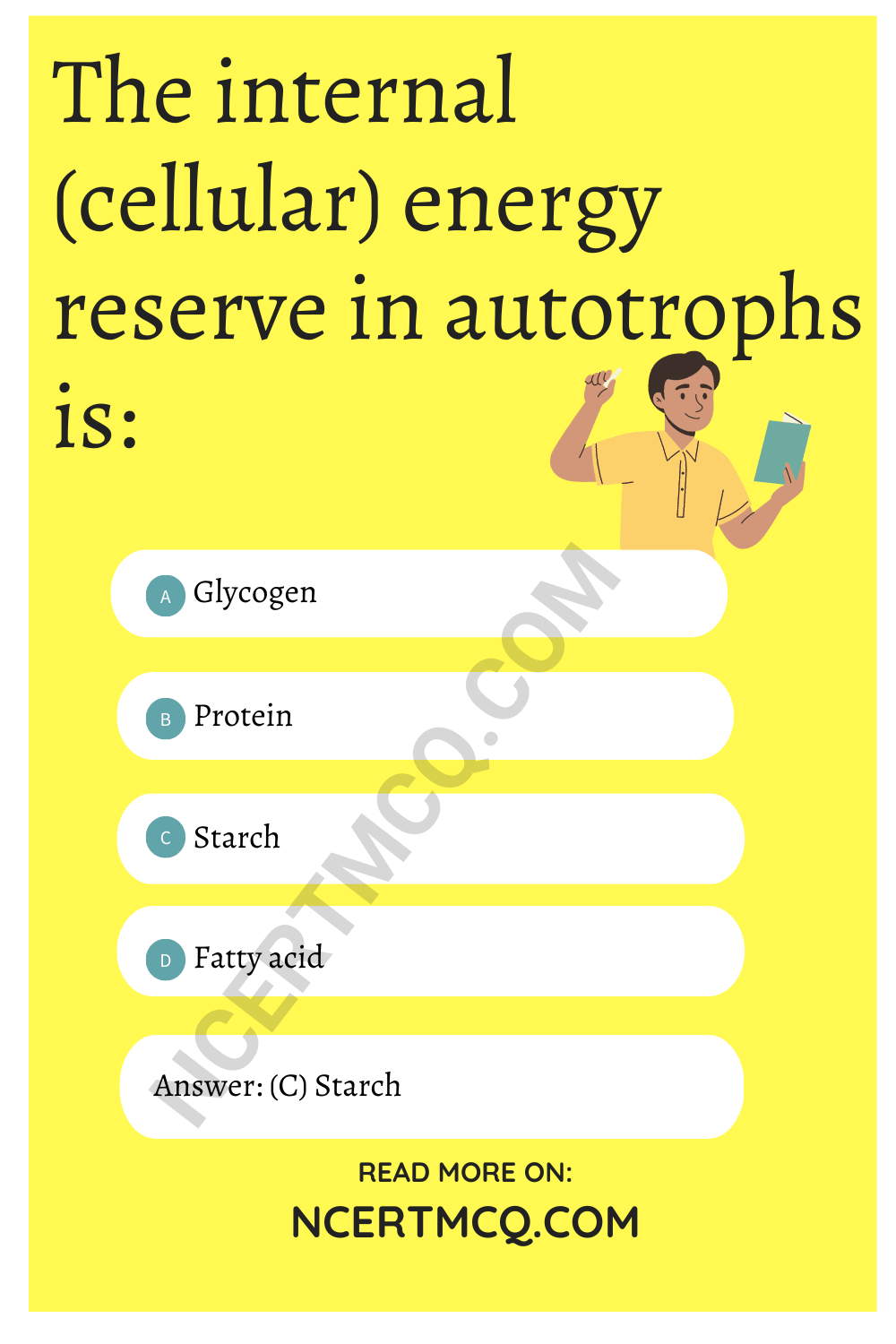
![]()
Question 21.
Choose the event that does not occur in photosynthesis.
(a) Absorption of light energy by chlorophyll
(b) Reduction of carbon dioxide to carbohydrates
(c) Oxidation of carbon to carbon dioxide
(d) Conversion of light energy to chemical energy
Answer:
Question 22.
Choose the forms in which most plants absorb nitrogen:
(I) Proteins
(II) Nitrates and Nitrites
(III) Urea
(IV) Atmospheric nitrogen
(a) (I) and (II)
(b) (II) and (III)
(c) (III) and (IV)
(d) (I) and (IV)
Answer:
Question 23.
The doctor measured Ravi’s blood pressure and said it is normal now. The range of Ravi’s blood pressure (systolic/diastolic) is likely to be:
(a) \(\frac{120}{80}\) mm of Hg
(b) \(\frac{160}{80}\) mm of Hg
(c) \(\frac{120}{60}\) mm of Hg
(d) \(\frac{180}{80}\) mm of Hg
Answer:
(a) \(\frac{120}{80}\) mm of Hg
Explanation: Blood pressure is denoted by two values: one value is above and the other value
is below. The value that is above is the systolic pressure and the one that is below is the diastolic pressure. A normal individual should maintain a systolic/diastolic pressure of \(\frac{120}{80}\) mm of Hg.
Related Theory
Blood pressure is the force applied by the blood against the walls of the arteries. The blood pressure is of two types – systolic and diastolic. The blood pressure of a normal individual is 120/80 mm ofHg. If a person has less blood pressure than normal, he/ she is said to have low blood pressure.
If a person has more blood pressure than normal, he/ she is said to have high blood pressure.
Question 24.
If the structure marked X in the diagram given below is blocked, then which of the processes will not occur?
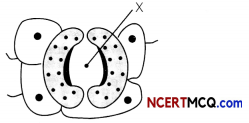
(a) Transpiration and respiration
(b) Transpiration, photosynthesis and respiration
(c) Respiration, transpiration and transportation
(d) Respiration and photosynthesis [Diksha]
Answer:
(b) Transpiration, photosynthesis and respiration Explanation: Here, the structure marked as X is stomata.
Stomata are responsible for gaseous exchange in the plant. If they are blocked, the gaseous exchange will not take place.
Hence, the two important processes of the plant: photosynthesis and respiration do not take place. Stomata are also responsible for removing extra water present in the plants.
Hence, if blocked, the process of transpiration will also be affected.
![]()
Question 25.
Which of the following statement(s) is incorrect about transport in plants:
(I) The transport in the xylem is achieved by utilizing energy.
(II) Transpiration helps in the absorption of water and minerals from the roots to the leaves.
(III) The transport of soluble products of photosynthesis occurs in the phloem.
(IV) Besides water, the xylem also transports amino acids and other substances.
(a) Both (I) and (III)
(b) Both (II) and (III)
(c) Both (I) and (IV)
(d) Both (III) and (IV)
Answer:
(c) Both (I) and (IV)
Explanation: Transport of water and minerals in xylem takes place by the process of osmosis due to difference in ionic concentration in the soil and inside the root. Transpiration pull helps in the absorption of water to the taller parts of a plant during the daytime when the stomata are open. The phloem transports the soluble products of photosynthesis, amino acids and some other substances.
Question 26.
Which of the following statements are incorrect about aerobic respiration?
(I) The first step is the breakdown of glucose into pyruvate.
(II) Glucose is a six-carbon molecule and pyruvate is a three-carbon molecule.
(III) The breakdown of glucose take place in the mitochondria.
(IV) The breakdown of pyruvate using oxygen takes place in the cytoplasm.
(a) Both (I) and (III)
(b) Both (II) and (IV)
(c) Both (III) and (IV)
(d) (I), (III) and (IV)
Answer:
Question 27.
A student noted the differences between blood and lymph in the following table. Select the row containing correct information:
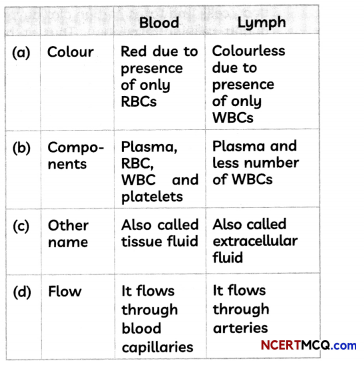
Answer:
(d) Blood: It flows through blood capillaries: Lymph: It flows through arteries
Explanation: Lymph drains into Lymph capillaries from the intercellular spaces which join to form large lymph vessels that finally open into larger veins.
![]()
Question 28.
Select the incorrect statement from the statements given below.
Waste products in plants:
(a) Are stored in the Golgi apparatus.
(b) Are stored in leaves that fall off.
(c) Are stored as resins and gums, especially in old xylem.
(d) Are excreted into the soil around them.
Answer:
(a) Are stored in the Golgi apparatus.
Question 29.
Which of the following part of the human excretory system is under nervous control?
(a) Ureters
(b) Urethra
(c) Urinary bladder
(d) Collecting duct
Answer:
(c) Urinary bladder
Explanation: The urinary bladder is a muscular structure that stores the urine until we get the urge to urinate. It is under nervous control.
Question 30.
In humans, the oxygen-rich blood from the lungs comes to the:
(a) Left atrium.
(b) Right atrium
(c) Left ventricle
(d) Right ventricle
Answer:
Question 31.
Select the incorrect statement:
(a) The arteries have thick, elastic walls
(b) The veins have thin walls
(c) Veins have valves to ensure that blood flows in one direction only.
(d) Arteries have valves to ensure that blood flows in one direction only.
Answer:
(d) Arteries have valves to ensure that blood flows in one direction only.
Explanation: Arteries do not have any valves as they carry blood away from the heart. They have thick and elastic walls as they bLood is under high pressure. Veins have valves to ensure that the blood flows in one direction only.
Assertion Reasoning questions Class 10 Science Chapter 6
For the following questions two statements are given- one labeled Assertion (A) and the other labeled Reason (R). Select the correct answer to these questions from the codes (a), (b), (c) and (d) as given below:
(a) Both (A) and (R) are true and (R) is correct explanation of the assertion.
(b) Both (A) and (R) are true but R is not the correct explanation of the assertion.
(c) (A) is true but (R) is false.
(d) (A) is false but (R) is true.
![]()
Question 32.
Assertion (A): Transpiration cools leaf surface.
Reason (R): Transpiration helps in translocation of sugar in plants. [Diksha]
Answer:
(c) (A) is true but (R) is false.
Explanation: Transpiration is the process by which plants lose extra water off their surface with the help of the stomata of the Leaves. The plants usually lose water during very hot season. As a result, the temperature of the plant decreases and it cools down. However, transpiration does not help in translocation of food in the plants. Therefore, the assertion is true but the reason accompanied is false.
Related Theory
Transpiration is an important plant process. The three important tasks that are accomplished due to transpiration are:
- Decrease in temperature of the plant: When the plants lose water, the temperature of the plant’s decreases and therefore, the plants cool down.
- Transpirational pull: When plants lose water, an empty space is created in the plants. As a result, the minerals and water from the root are pulled up. This process is called transpirational pull.
- Plant turgidity: Transpiration helps plants in maintaining the turgidity of the plants.
Question 33.
Assertion (A): The leaves which are partly green and partly white are called variegated leaves.
Reason (R): The green part of such a leaf contains chlorophyll but the writing part does not contain chlorophyll.
Question 34.
Assertion (A): Human beings have a complex respiratory system.
Reason (R): Human skin is impermeable to gases.
Answer:
(b) Both (A) and (R) are correct but the R is not the correct explanation of the Assertion. Explanation: Human skin is impermeable to gas to minimise the loss of water from the skin.
Question 35.
Assertion (A): Autotrophs can produce food on its own.
Reason (R): Green plants can absorb the energy of sunlight that falls on the leaves.
Answer:
(b) (A) is true but (R) is false.
Explanation: All the green plants are called autotrophs. This is due to the fact that the green plants make their own food from very simple substances like carbon dioxide and water that is present in the surroundings.
The green plants in a terrestrial ecosystem capture about 1% energy of sunlight that falls on their leaves and convert it to into food energy.
![]()
Question 36.
Assertion (A): Hydrochloric acid secreted in the stomach makes an acidic medium for the action of the enzyme pepsin.
Reason (R): Bile juice from liver will make the medium alkaline in the small intestine for the panereatic juices to act.
Answer:
Question 37.
Assertion (A): The opening and closing of the pore is a function of the guard cells.
Reason (R): Stomatal pores are the site for an exchange of gases by diffusion.
Answer:
(b) Both (A) and (R) are correct but the R is not the correct explanation of the Assertion.
Related Theory:
Tiny pores present on the surface of leaves of plants are called stomata. Each stomatal pore is surrounded by a pair of guard cells.
When water flows into the guard cells, they swell, become curved and cause the pore to open. Similarly when the guard cells lose water, they shrink and the stomatal pore closes.
Question 38.
Assertion (A): Respiration is an exothermic reaction.
Reason (R): Respiration is processes in which glucose combines with oxygen and decompose to carbon dioxide and water this reaction also release some energy.
Answer:
(a) Both A and R are true, and R is correct explanation of the assertion.
![]()
Question 39.
Assertion (A): The inner lining of the small intestine does not have numerous finger-like projections called villi.
Reason (R): The villi increase the surface area for absorption.
Answer:
(d) A is false, but R is true.
Explanation: The inner lining of the small intestine have numerous finger-like projections called villi and these villi increase the surface area for absorption. Thus A is false, but R is true.
Question 40.
Assertion (A): Oxygenated blood flows in the pulmonary artery.
Reason (R): Arteries have a narrow lumen.
Answer:
Question 41.
Assertion (A): Glucose is absorbed in the small intestine and reabsorbed by the kidney tubules.
Reason (R): Maximum absorption of glucose takes place in the large intestine.
Answer:
(c) A is true, but R is false.
Explanation: Glucose is absorbed in the small intestine and reabsorbed by the kidney tubules and its maximum absorption takes place in the small intestine. Thus A is true, but R is false
(Competency-Based Questions)
Question 1.
Gargi loved eating sugar candies. So, whenever she went to local melas or school trips, she would have only sugar candies.
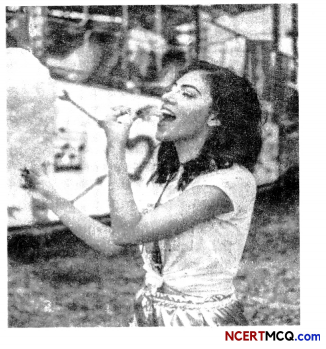
Which is the first enzyme to mix with food in the digestive tract?
(a) Pepsin
(b) Cellulase
(c) Amylase
(d) Trypsin
Answer:
(c) Amylase
Explanation: Food digestion process begins in the mouth. Mouth contains salivary gLands that secrete saliva. Saliva contains an important enzyme known as salivary amylase that breaks down starch into simple sugars. Pepsin is a protein-digesting enzyme. Stomach contains gastric glands that secrete mucus, hydrochloric acid and pepsin.
![]()
Question 2.
Raima joined aerobics classes in her neighbourhood along with her friend. On the very first day, her instructor told them to always do these exercises in a well-ventilated room. She later found out the reason why her instructor had said so
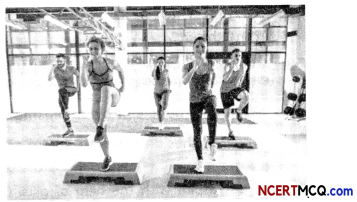
| Aerobic respiration | Anaerobic respiration |
| (a) It takes place In presence oxygen | It takes place in of absence of oxygen |
| (b) end products are carbon dioxide and water and energy | End products are carbon dioxide, energy |
| (c) Large amount of energy is released | Less amount of energy is released |
| (d) It takes Place in muscles cells | It takes place in Mitochondria yeast and human |
Question 3.
Why do we need carbohydrates in our diet? Carbohydrates are our body’s main source of energy. They help fuel the brain, kidneys, heart muscles, and central nervous system. For instance, fibre is a carbohydrate that aids in digestion, helps one feel full, and keeps blood cholesterol levels in check. Some of the food items rich in carbohydrates are Breads, grains, and pasta, Nuts and Legumes, Starchy Vegetables, Milk and yogurts, Fruits and Snack Foods.
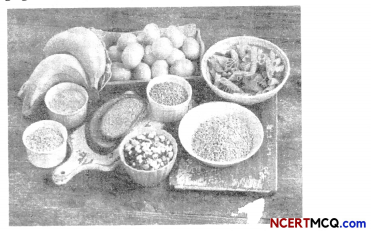
What happens during digestion of carbohydrates?
(a) Specific hormones break down carbohydrates into simple sugar such as glucose.
(b) Specific enzymes break down carbohydrates into fatty acids and glycerol.
(c) Specific enzymes break down carbohydrates into simple sugar such as glucose.
(d) Specific hormones break down carbohydrates into fatty acids and glycerol.
Answer:
(c) Specific enzymes breakdown carbohydrates into simple sugar such as glucose. Explanation: The digestion of food is the break down of complex food substances by the enzymes secreted by various parts of the digestive system. Hormones are secreted by the endocrine glands and act on specific targets.
![]()
Question 4.
Table A (Blood glucose chart)
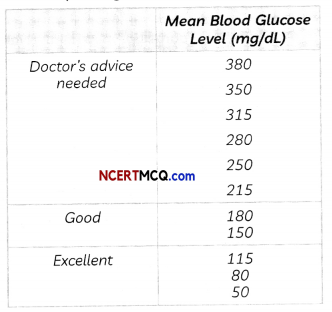
Table B (Blood Report of Patient X and Y)
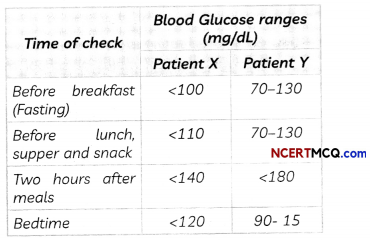
(A) Refer to Table B showing the blood report of the levels of glucose of patients X and Y. Infer the disease which can be diagnosed from the given data.
Answer:
Diabetes
(B) Identify the hormone whose level in the blood is responsible for the above disease.
Answer:
(C) Which one of the following diets would you recommended to the affected patient?
(a) High sugar and low fat diet.
(b) Low sugar and high protein diet.
(c) High Fat and low fiber diet.
(d) Low sugar and high fiber diet.
Answer:
(d) low sugar high fibre diet
(D) Refer to Table A and suggest the value of the mean blood glucose level beyond which doctor’s advice is necessary:
(a) 180 mg/dL
(b) 115 mg/dL
(c) 50 mg/dL
(d) 80 mg/dL
Answer:
180 mg/dL
Question 5.
Kidneys are vital organs for survival. In case of kidney failure an artificial kidney can be used. An artificial kidney is a device to remove nitrogenous waste products from the blood through dialysis.
(A) What are the functions of kidneys?
Answer:
The functions of kidneys are:
(1) To remove nitrogenous waste from the blood.
(2) To maintain salt and water balance in the body.
(B) Name the filtration units present in kidneys.
Answer:
The filtration units present in the kidneys are nephrons.
(C) What is the excretory product removed by kidneys from blood?
Answer:
(D) Name two substances which are selectively reabsorbed from nephric filtrate into the blood.
Answer:
Two substances which are selectively reabsorbed from nephric filtrate into the blood are glucose, amino acids, salts and a major amount of water. (Any two)
Related Theory:
Bowman’s capsules of nephrons acts as ultra filters. Blood flows inside the glomerular capillaries under pressure and water with dissolved molecules from blood plasma diffuses out into Bowman’s capsule. The fluid collected in the Bowman’s capsule as a result of ultrafiltration is called nephric filtrate.
Question 6.
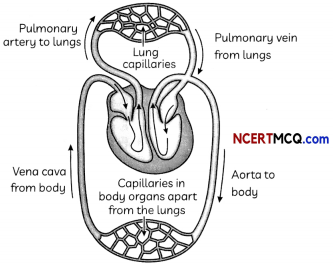
Oxygen-rich blood from the lungs comes to the thin-walled upper chamber of the heart on the left, the left atrium. The left atrium relaxes when it is collecting this blood. It then contracts, while the next chamber, the left ventricle, expands, so that the blood is transferred to it. When the muscular left ventricle contracts in its turn, the blood is pumped out to the body. De-oxygenated blood comes from the body to the upper chamber on the right, the right atrium, as it expands. As the right atrium contracts, the corresponding lower chamber, the right ventricle, dilates. This transfers blood to the right ventricle, which in turn pumps it to the lungs for oxygenation.
Since ventricles have to pump blood into various organs, they have thicker muscular walls than the atria do. Valves ensure that blood does not flow backwards when the atria or ventricles contract.
(A) Name the organs of the circulatory system in human.
Answer:
The various organs of the circulatory system in humans are: heart, arteries, veins and capillaries.
(B) Name the red pigment which carries oxygen in the blood.
Answer:
The red pigment which carries oxygen in the blood is Haemoglobin.
(C) How many chambers are there in the heart of an amphibian?
Answer:
(D) Why is it necessary to separate oxygenated and deoxygenated blood in mammals and birds?
Answer:
It is necessary to separate the oxygenated blood from mixing with deoxygenated blood as mammals and birds have high energy needs because they constantly require energy to maintain their body temperature.
![]()
Question 7.
The haemoglobin level is expressed as the amount of haemoglobin in grams (g) per deciliter (di) of whole blood, a deciliter being 100 milliliters. The normal ranges for hemoglobin depend on the age and, beginning in adolescence, the gender of the person. The normal ranges are:
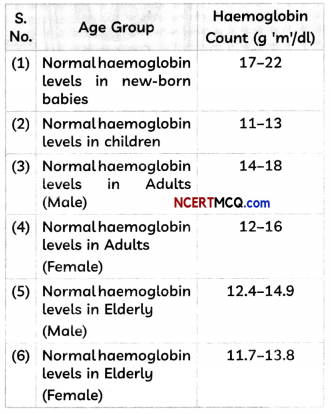
Based on the above table answer the following questions
(A) What does o Low haemoglobin Level mean?
Answer:
A low haemoglobin level is rererred to as anemia or low red blood count.
Explanation: A lower than normal number of red blood ceLls is referred to as anaemia and hemoglobin evets reflect this number.
(B) How is oxygen transported in human beings?
Answer:
Transport of oxygen: Hoemoglobin present in the red blood corpuscles takes up the oxygen from the oir in the lungs. It carries the oxygen to tissues which are deficient in oxygen before releasing it.
(C) Respiratory pigment in human body is
(a) Chlorophyll
(b) Water
(c) Blood
(d) Haemoglobin
Answer:
(d) Haemoglobin
Explanation: Respiratory pigment in human body is haemoglobin.
(D) Which of the following is an important component of haemoglobin?
(a) Iron
(b) Sodium
(c) Calcium
(d) Magnesium
Answer:
![]()
Question 8.
Two students performed the following activities to understand the conditions necessary for photosynthesis.
The first student took a potted plant with variegated leaves – for example, money plant or crotons. He first kept the plant in a dark room for three days and then kept it in sunlight for about six hours. He plucked a leaf from the plant and marked the green areas in it and traced them on a sheet of paper. He then dipped the leaf in boiling water for a few minutes. After this, he immersed it in a beaker containing alcohol and carefully placed the above beaker in a water-bath and heated till the alcohol began to boil.
He dipped the leaf in a dilute solution of iodine for a few minutes, then took out the leaf and rinsed off the iodine solution. He based his conclusions by observing the colour of the leaf and comparing this with the tracing of the leaf done in the beginning.
The second student took two healthy potted plants which were nearly the same size and kept them in a dark room for three days. He then placed each plant on separate glass plates. He placed a watch-glass containing potassium hydroxide by the side of one of the plants and covered both plants with separate bell-jars as shown in Fig. below.
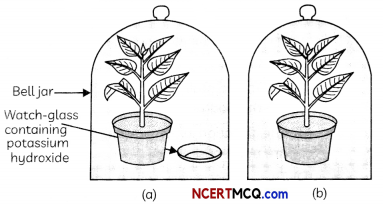
He used vaseline to seal the bottom of the jars to the glass plates so that the set-up is air¬tight and kept the plants in sunlight for about two hours. He then plucked a leaf from each plant and checked for the presence of starch as in the first activity.
(A) The first student noted down the following changes in colour of leaf and colour of alcohol solution after dipping
the Ipaf in boiling alcohol. Select the correct observation:
| Colour of Leaf | Colour of Alcohol Solution |
| (a) Leaf becomes colourless | No change in colour |
| (b) No change in colour | No change in colour |
| (c) Leaf becomes colourless | Alcohol solution turns green |
| (d) No change in colour | Alcohol solution turns green |
Answer:
(c) Colour of leaf: Leaf becomes colourless; Colour of alcohol solution: Alcohol solution turns green Explanation: The green leaf becomes colourless because on immersing green leaf in alcohol, chlorophyll responsible for its green colour gets dissolved in alcohol. The colour of the alcohol solution therefore turns green.
(B) The second student placed a watch glass containing potassium hydroxide in one bell jar as:
(a) Potassium hydroxide absorbs carbon dioxide gas present in the bell jar.
(b) Potassium hydroxide absorbs moisture present in the bell jar.
(c) Potassium hydroxide absorbs oxygen gas present in the hell jar.
(d) Potassium hydroxide reacts with carbon dioxide gas to form a compound.
Answer:
(a) Potassium hydroxide absorbs carbon dioxide gas present in the bell jar. Explanation: As the student wants to show that carbon dioxide is essential for photosynthesis, he sealed both the bell jars with vaseline and placed potassium hydroxide in one bell jar as potassium hydroxide absorbs carbon dioxide gas present in the bell jar. The plant in this bell jar will not be able to perform photosynthesis as carbon dioxide has been removed from the bell jar.
(C) Given below are four statements regarding the conclusions of the activities performed by the two students:
(I) The first student concluded that carbon dioxide is essential for photosynthesis.
(II) The first student concluded that chlorophyll is essential for photosynthesis.
(III) The second student concluded that carbon dioxide is essential for photosynthesis.
(IV) The second student that water is essential for photosynthesis.
Select the correct statement(s):
(a) Both (I) and (III)
(b) Both (II) and (III)
(c) Both (III) and (IV)
(d) (I), (III) and (IV)
Answer:
(D) Select the incorrect statement:
When the decolorized leaf is dipped in iodine solution by the first student, he observes that:
(a) There are two color regions in the leaf which are reddish brown and blue-black.
(b) The earlier green parts of the leaf turned blue black
(c) The earlier yellow turned reddish brown.
(d) The entire leaf turned blue-black.
Answer:
(E) Select the correct statement:
(a) The two leaves from the bell jars in the activity performed by the second student showed the presence of different amount of starch
(b) The second student used tape to seal the bottom of the jars to the glass plates.
(c) Both the students first dipped the leaves in boiling alcohol to kill a leaf and stop chemical reactions occurring in it.
(d) Plants are kept in the dark for three days to remove all the chlorophyll from the leaves.
Answer:
(a) The two leaves from the bell jars in the activity performed by the second student showed the presence of different amount of starch
Explanation: In the first set up availability of C02 will be less for making starch by the plant leaves, as potassium hydroxide (KOH) absorbs the CO2. In second plant setup, the leaves will have more amount of starch. So. the amount of starch wilt be different in the two leaves.
Question 9.
In the first activity, a student Rudra took some freshly prepared lime water in two test tubes marked A and & He blew air through the lime water in test tube A. He then used a syringe or pichkari and passed air through the fresh lime water in test tube B.
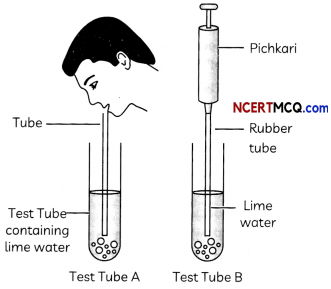
In the second activity, another student Siya took some fruit juice or sugar solution and took this mixture in a test tube fitted with a one-holed cork and fitted the cork with ci bent glass rube. She dipped the free end of the glass tube into a test tube containing freshly prepared time water.
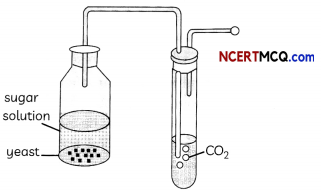
(A) Ridra recorded his observations below.
Select the correct observation.
| Test Tube A | Test Tube B |
| (a) No change observed | Lime water turned milky immediately |
| (b) Lime water turned milky immediately | No change observed |
| (c) Lime water turned milky immediately | Lime water turned milky after a Long time |
| (d) Lime water turned milky after a Long time | Lime water turned milky immediately |
Answer:
(c) Test Tube A: Lime water turned milky immediately; Test Tube B: Lime water turned milky after a long time
Explanation: Lime water turns milky when carbon dioxide gas is passed through it as a white precipitate of calcium carbonate is formed when lime water (calcium hydroxide) reacts with carbon dioxide gas. Lime water turns milky in test tube A as the exhaled air is rich in carbon dioxide. Whereas, lime water takes a lot of time to turn milky in test tube B as the amount of carbon dioxide present in atmesphereic air is very less as compared to exhaled air and hence carbon dioxide is produced after a long time.
(B) Select the incorrect observation from the statements given below:
(I) The amount of carbon dioxide in atmospheric oir and exhaled air are equal
(II) Exhaled air contains more carbon dioxide as compared to atmospheric air.
(III) Atmospheric air contains more carbon dioxide as compared to exhaled air.
(IV)Lime water turned milky immediately in both the test tubes A and B.
(a) Both (I) and (IV)
(b) Both (II) and (IV)
(c) Both (I), (II) and (III)
(d) Both (I), (III) and (IV)
Answer:
(d) Both (I), (III) and (IV)
Explanation: The amount of carbon dioxide is more in exhaled air and very less in the atmosphere. The lime water turns milky immediately in test tube A as the exhaled air contains large amount of carbon dioxide gas whereas it takes lot of time to turn milky in test tube B as fermentation by yeast is a very slow process.
(C) In the second activity, Siya observed that:
(a) Lime water in the test tube turned milky after some time
(b) Lime water in the test tube turned milky immediately
(c) No change observed in the coLour of Lime water
(d) Lime water in the test tube turned blue black
Answer:
(a) Lime water in the test tube turned milky after some time
Explanation: The lime water becomes milky after some time as carbon dioxide is produced as a result of fermentation of sugar on mixing yeast. The other product formed is alcohol.
(D) Setect the correct statement:
It can be concluded that:
(a) Carbon dioxide is produced as a result of digestion of food in the first activity.
(b) Carbon dioxide is produced as a result of aerobic respiration in the first activity.
(c) Oxygen is produced as a result of aerobic respiration in the first activity.
(d) Lactic acid is produced as a resuLt of anaerobic respiration in the second activity.
Answer:
(E) The products of fermentation in yeast are:
(a) Carbon dioxide and energy
(b) Lactic acid and energy
(c) Ethanol, carbon dioxide and energy
(d) Water, carbon dioxide and energy
Answer:
![]()
Question 10.
The unfolding COVID-19 pandemic has led to a global crisis which threatens to become a health, economic and humanitarian disaster. COVID-19 or COronaVIrus Disease 2019 is the term used by the WHO to refer to disease caused by this virus. The virus was also called 2019-nCoV (or 2019 novel CoronaVirus) prior to being official named by the WHO. COVID-19 is predominantly a respiratory disease, with severity ranging from mild to fatal, and transmission mostly from the spread of respiratory droplets. SARS-CoV-2 is transmitted person-to-person, predominantly by respiratory droplet spread and contact, similar to the MERS and SARS corona viruses.
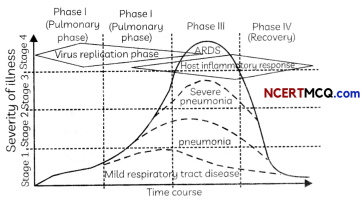
(A) Select the incorrect statement about the COVID-19 disease:
(a) COVID-19 disease is caused by a virus.
(b) It is a respiratory disease
(c) It is transmitted mostly by respiratory droplets.
(d) It can be cured by taking antibiotics.
Answer:
(B) From the statements given below, identify the incorrect cause of the disease:
| Respiratory Disease | Cause |
| (a) Tuberculosis | Infection of trachea |
| (b) Emphysema | Reduction of gas exchange area of the lungs |
| (c) Asthma | constriction of the bronchi and bronchioles |
| (d) Pneumoria | An infection of the alveoli |
Answer:
(a) Respiratory Disease: Tuberculosis;
Cause: Infection of trachea.
Explanation: Tuberculosis is a potentially serious infectious bacterial disease that mainly affects the lungs.The bacteria that cause TB are spread when an infected person coughs or sneezes.
(C) In the respiratory system, an extensive network of blood vessels is present in:
(a) Bronchioles
(b) Alveoli
(c) Trachea
(d) Pharynx
Answer:
(b) Alveoli
Explanation: Within the lungs, the
passage divides into smaller and smaller tubes which finally terminate in balloon-like structures which are called alveoli. The alveoli provide a surface where the exchange of gases can take place. The walls of the alveoli contain an extensive network of blood-vessels.
(D) Given below are four statements about respiration. Identify the correct statement (s).
(I) During inhalation, the chest cavity becomes larger.
(II) Exchange of gases takes place in the bronchioles.
(III) Alveoli increase surface area for exchange of gases.
(IV) Haemoglobin has greater affinity for carbon dioxide than oxygen.
(a) Both I and II
(b) Both II and III
(c) Both I and ill
(d) Both II and IV
Answer:
(c) Both I and III
Explanation: During inhalation of air, our chest cavity or thoracic cavity expands. The exchange of gases takes place in the alveoli, which are balloon like structures in our lungs. These have very thin walls which are richly supplied with blood capillaries. Haemoglobin has a greater affinity for oxygen and isc arried by blood for oxygen and oxygen is carried by the blood to different parts as oxy haemoglobin, whereas carbon dioxide is transported in dissolved form.
(E) Which one of the following statements is false about the trachea?
(a) It has rings of cartilage
(b) it is covered by epiglottis
(c) It splits into the right and left lungs
(d) It is also called windpipe.
Answer:
![]()
Question 11.
COVID-19 is a respiratory disease, one that especially reaches into your respiratory tract, which includes your lungs. Now, think of your respiratory tract as an upside-down tree. The trunk is your trachea, or windpipe. It splits into smaller and smaller branches in your lungs. At the end of each branch are tiny air sacs called alveoli. The new coronavirus travels down your airways. The lining can become irritated and inflamed. In some cases, the infection can reach all the way down into your alveoli.
(A) What is the function of alveoli?
(a) This is where SARS-CoV-2, the virus that causesCOVID-19 finally affects.
(b) This is where plasma, proteins and blood cells escapes inthe tissues
(c) This is where oxygen goes into your blood and carbon dioxide comesout.
(d) Alveoli carries fat and drains excessive fluid back into the blood.
Answer:
(c) This is where oxygen goes into your blood and carbon dioxide comes out.
Explanation: Alveoli act as the passage gateway for the exchange of the gases between the surroundings and the body.
(B) Your blood oxygen level indicates how much oxygen your red blood cells are carrying. High blood oxygenation plays an essential role in ensuring that your muscles, brain and other organs receive the energy they need to function properly. That’s why it is so important to measure your current level and determine whether it is within an acceptable range.
Why is it important to measure your current oxygen level?
(a) To know how much blood is flowing
(b) To know how much oxygen is flowing in the blood.
(c) To know how your brain is working
(d) To know the heart rate
Answer:
(C) The lungs are the organ most commonly affected by COVID-19. If large parts of the lungs are affected, people struggle to absorb enough oxygen and are admitted to hospital. Another severe effect is acute respiratory distress syndrome (ARDS) – also known as “wet lung”. This sees severe inflammation spread quickly throughout the lungs. People who develop this may need mechanical ventilation in an intensive care unit, sometimes for a prolonged period. COVID-19 has a further, unusual effect on the body. Compared to other respiratory viruses, it causes marked clotting in the small blood vessels of the lungs and other organs.
How are the lungs affected by COVID-19?
(A) Blood clotting
(B) Lack of oxygen
(C) Severe inflammation
Now choose the correct option.
(a) A and B only
(b) B and C only
(c) None of these
(d) A, B and C or either of these
Answer:
(D) Haemoglobin is an iron containing respiratory pigment that carries oxygen through red blood cells. Presence of Haemoglobin gives metallic taste to the blood. Haemoglobin is an intracellular protein which acts as a primary vehicle for transporting 97% of oxygen in the blood.
Which is not true about Haemoglobin?
(a) It is a respiratory pigment.
(b) It has a high affinity for oxygen and carbon dioxide.
(c) it is present in RBCs.
(d) Its deficiency causes anaemia.
Answer:
(b) It has a high affinity for oxygen and carbon dioxide.
Explanation: Haemoglobin has high affinity for carbon dioxide since it forms the coordinate complex between the Fe and C leading to resist the ability of the oxygen to carry the oxygen leading to various respiratory disorders.
(E) In the given picture, “A” represents
(a) Rings of cartilage which ensures that the air passage does not collapse while going into the lungs.
(b) Diaphragm which contracts and flattens upon inhalation.
(c) Alveoli where the exchange of gases can take place.
(d) Fine hairs for air filtration.
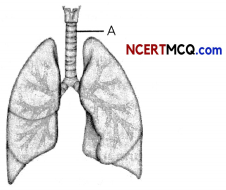
Answer:
(a) Rings of cartilage which ensures that the air passage does not collapse while going into the lungs.
![]()
Question 12.
Multicellular organisms with small surface area to volume ratios need transport systems. Water and mineral salts are transported through a plant in xylem vessels. Transpiration is the process of water movement through a plant and its evaporation from aerial parts, such as leaves, stems and flowers. Water is necessary for plants but only a small amount of water taken up by the roots is used for growth and metabolism.
The pattern of water uptake and loss by sunflower plant during 24 h is shown in the graph below:
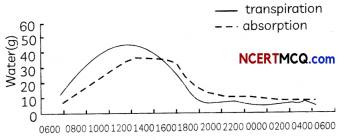
The movement of sucrose and other substances like amino acids around a plant is called translocation. Translocation of organic solutes such as sucrose occurs through living phloem sieve tubes. Both xylem vessels and phloem sieve tubes show unique structural features which are adaptations to their roles in transport.
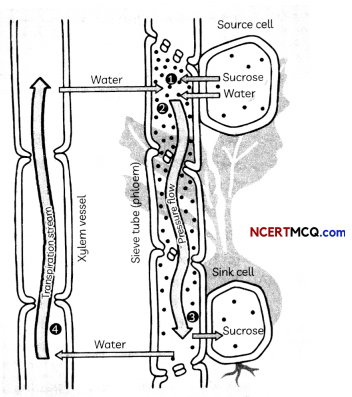
(A) Root pressure is maximum when
(a) Transpiration is very high and absorption is very low
(b) Transpiration is very low and absorption is very high
(c) Both transpiration and absorption are very high
(d) Both the absorption and transpiration are very low
Answer:
(b) Transpiration is very low and absorption is very high
Explanation: At night, when there is no sunlight, transpiration is very low but the absorption of substances by roots is high.
(B) Select the row containing incorrect information:
| Cell | Vascular Tissue |
| (a) Vessels | Xylem |
| (b) Sieve tube | Xylem |
| (c) Tracheids | Xylem |
| (d) Companion cell | Phloem |
Answer:
(b) Cell: Sieve tube: Vascular Tissue: Xylem.
Explanation: Xylem is the conducting tissue for water and minerals and consists of vessels, tracheids and xylem parenchyma. Phloem on the other hand transports the dissolved products of photosynthesis and consists of sieve tubes, phloem parenchyma and companion cells.
(C) Given below are some statements about transport in plants:
(I) Xylem transports water, amino acids and other substances in plants.
(II) Phloem transports soluble products of photosynthesis in plants.
(III) Transpiration helps in absorption of water.
(IV) Material like sucrose is transferred into phloem tissue using energy from ATP
Select the correct statement (s):
(a) Both (I) and (II)
(b) Both (II) and (III)
(c) (I), (II) and (IV)
(d) (II), (III) and (IV)
Answer:
(d) (II), (III) and (IV)
Explanation: Xylem transports water and minerals from the soil to different parts of the plant in upward direction.
PhLoem transports the soluble products of photosynthesis from the leaves to different parts of the plant by using energy from ATP. It also transports amino acids and other substances in plants. Transpiration is the loss of water by the aerial parts of the plant during day time which helps in creating a transpiration pull due to which water moves upward in xylem.
(D) The major driving force in the movement of water from ground to the root during day is:
(a) Osmosis
(b) Imbibition
(c) Transpiration pull
(d) Plasmolysis
Answer:
(E) Water will be absorbed by the root hairs when the external medium is
(a) Isotonic
(b) Hypertonic
(c) Hypotonic
(d) Viscous
Answer:
Question 13.
The food material taken in during the process of nutrition is used in cells to provide energy for various life processes. Diverse organisms do this in different ways – some use oxygen to break-down glucose completely: some use other pathways that do not involve oxygen.
(A) Name the two ways in which glucose is oxidised to provide energy in various organisms.
(a) Aerobic respiration and Anaerobic respiration
(b) Respiration and breathing
(c) Fermentation and breathing
(d) None of the above
Answer:
(a) Aerobic respiration and anaerobic respiration
Explanation: The two ways through which glucose is oxidised to provide energy in various organisms is through the aerobic and anaerobic respiration. Aerobic respiration occurs during the presence of air., whereas the anaerobic respiration occurs in the absence of air.
(B) The characteristic processes observed in anaerobic respiration are
(I) Presence of oxygen
(II) Release of carbon dioxide
(III) Release of energy
(IV) Release of lactic acid
(a) A and B only
(b) A,B,C only
(c) B, C, D only
(d) D only
Answer:
(C) Fatigue in muscles occurs due to
(a) Aerobic respiration
(b) Anaerobic respiration
(c) Anaerobic fermentation
(d) Breathing
Answer:
(b) Anaerobic respiration
Explanation: In the anaerobic respiration the release of the carborl dioxide takes along with the release of the energy and lactic acid thus fatigue in the muscles occur due to this phenomenon.
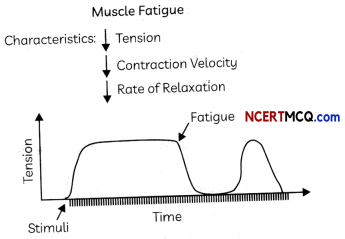
(D) Break-down of pyruvate using oxygen takes place in the
(a) Mitochondria
(b) Cytoplasm
(c) Chloroplast
(d) Golgi apparatus
Answer:
(E) In humans, however, we respire anaerobically when the heart and lungs cannot work fast enough to provide enough oxygen around the body to break down the glucose. This causes formation of:
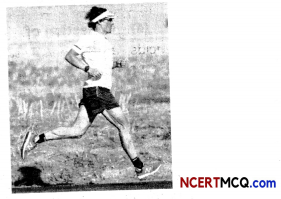
(a) Ethanol
(b) Carbon dioxide
(c) Lactic acid
(d) All the above
Answer:
(c) Lactic acid
Explanation: Lactic acid is formed when we respire anaerobically when the heart and lungs cannot work fast enough to provide enough oxygen around the body to break down the glucose.
![]()
Question 14.
Diabetes meilitus, usually caiLed diabetes, is a disease in which your body does not make enough insulin or cannot use normal amounts of insulin properly.
The kidneys play an important role in regulating *glucose homeostasis through utilization of glucose, gluconeogenesis, and glucose reabsorption. Glucose is freely filtered by the glomerulus. Glomerular filtration rate (GFR) represents the flow of plasma from the glomerulus into Bowman’s space over a specified period and is the chief measure of kidney function. Under normal conditions, ~ 180 g of glucose are filtered by the kidney each day. More than 99% of this glucose is reabsorbed by the proximal tubule, with < 0.5 g/day excreted in the urine of healthy adults. When the filtered glucose load exceeds the tubular maximum glucose reabsorptive capacity, excess glucose is excreted in the urine.
The physiological relationship between plasma glucose concentration and renal glucose flux (ie, filtration, reabsorption, and excretion) is shown below:
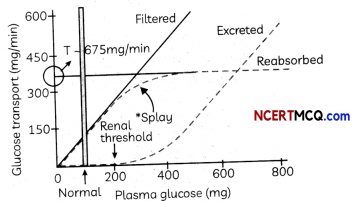
(A) The incorrect conclusion from the graph showing amount of glucose filtered by the kidneys is:
(a) The amount of glucose filtered by the kidneys increases in a linear manner with increasing plasma glucose concentration
(b) Under normal conditions in healthy individuals, nearly all filtered glucose is reabsorbed in the renal tubules
(c) The renal glucose reabsorption increases linearly with increasing plasma glucose concentration.
(d) There is a distinct deviation (the “splay”) from this linear relationship as the renal capacity to reabsorb glucose nears saturation.
Answer:
(c) The renal glucose reabsorption increases linearly with increasing plasma glucose concentration.
Explanation: The renal glucose reabsorption increases linearly until a certain concentration of plasma glucose is present. After the saturation limit of glucose is reached, it does not change.
(B) The excretory system of human beings include
(a) A kidney, a ureter, a urinary bladder and a urethra
(b) A pair of kidneys, a ureter, a pair of urinary bladders, and a urethra
(c) A pair of kidneys, a pair of ureters, a urinary bladder and a urethra
(d) A pair of kidneys, a pair of ureters, a pair of urinary bladders and a urethra
Answer:
(C) Which of the following statements) is correct about excretion in human beings?
(I) Kidneys are the primary excretory organs.
(II) Nitrogenous waste such as urea or uric acid are removed from blood in the kidneys.
(III) The basic filtration unit in the kidneys is a cluster of very thin- walled blood Capillaries.
(IV) Urine is stored in the urethra until the urge of passing it out.
(a) Both (I) and (II)
(b) Both (I) and (III)
(c) (I), (III) and (IV)
(d) (I), (II) and (III)
Answer:
(d) (I), (II) and (III)
Explanation: The only incorrect statement is that urine is stored in the urethra, as urine is actually stored in the urinary bladder, which is a muscular organ and under our nervous control.
(D) The correct function of parts labelled ‘A’ and ‘B’ in the figure below is:
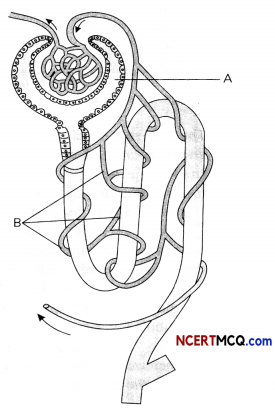
| Part ‘A’ | Part ‘B’ |
| (a) Filtration of blood | Reabsorption of glucose, salts and amino acids |
| (b) Reabsorption of glucose, salts and amino acids | Filtration of blood |
| (c) Reabsorption of hormones from blood | Filtration of blood |
| (d) Collection of urine | Reabsorption of glucose,salts and amino acids |
Answer:
(a) part ‘A’ : Filtration of blood; part ‘B’ : Reabsorbtion of glucose, Salts and amino acids
Explanation: Part labelled A is the Bowman’s capsule which is a cup-like sac at the beginning of the tubular component of a nephron in the mammalian kidney. Fluids from blood in the glomerulus are collected in the Bowman’s capsule and further processed along the nephron to form urine.
Part labelled B is the tubular part of the nephron where some substances in the initial filtrate, such as glucose, amino acids, salts and a major amount of water, are selectively re-absorbed as the urine along the tube.
(E) The part labelled ‘A’ in the figure above is:
(a) Glomerulus
(b) Bowman’s Capsule
(c) Proximal tubule
(d) Distant convoluted tubule
Answer:
Question 15.
Blood being a fluid connective tissue. Blood consists of fluid medium called plasma in which the cells are suspended. Plasma transports food, carbon dioxide and nitrogenous wastes in dissolved form. Oxygen is carried by the red blood corpuscles. Many other substances like salts are also transported by the blood. l/l/e thus need a pumping organ to push blood around the body, a network of tubes to reach all the tissues and a system in place to ensure that this network can be repaired if damaged. The force that blood exerts against the wall of a vessel is called blood pressure. This pressure is much greater in arteries than in veins. The pressure of blood inside the artery during ventricular systole (contraction) is called systolic pressure and pressure in artery during ventricular diastole (relaxation) is called diastolic pressure. The normal systolic pressure is about 120 mm of Hg and diastolic pressure is 80 mm of Hg.
(A) Blood consists of a fluid medium called as:
(a) Plasma
(b) Red blood corpuscles
(c) White blood corpuscles
(d) Lymph
Answer:
(a) Plasma
Explanation: Blood consists of the 90% water in the form of the ions and the dissolved state known as plasma.
(B) Oxygen is transported in the body by combining with:
(a) Haemoglobin and iron only
(b) Haemoglobin only
(c) Plasma, Haemoglobin and iron
(d) None of these
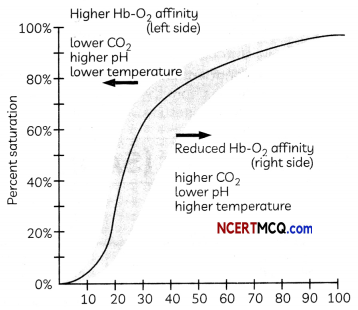
Answer:
(C) The oxygenated blood is sent to different body parts by:
(a) Arteries
(b) Veins
(c) Heart
(d) Circulatory system
Answer:
(a) Arteries
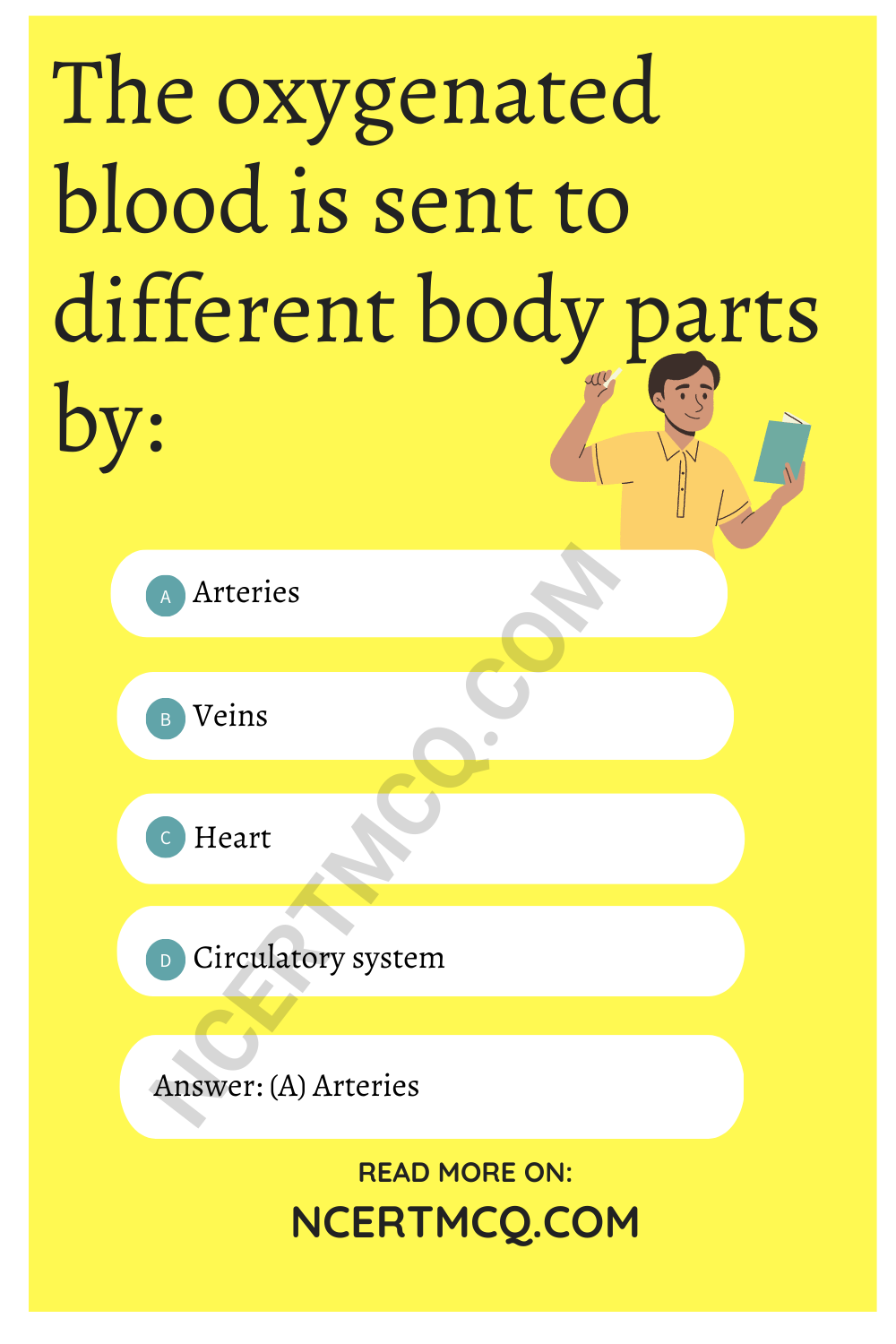
Explanation: Arteries carry the oxygenated blood that is the pure blood to the different parts of the body whereas the deoxygenated blood is carried by the veins from the different body parts back to the heart.
(D) In fish and men the pumping organ to push blood are
(a) 2 and 3 chambered respectively
(b) 2 and 4 chambered respectively
(c) 4 and 2 chambered respectively
(d) 2 and 2 chambered each
Answer:
(b) 2 and 4 chambered respectively
Explanation: In fish and men the pumping organ to push blood is 2 and 4 chambered respectively in human’s two auricles and two ventricles are there for the separation of the oxygenated and the deoxygenated blood.
(E) The force that blood exerts against the wall of a vessel is
(a) More in arteries and less in vein
(b) More in veins and less in arteries.
(c) More in blood capillaries
(d) More in heart
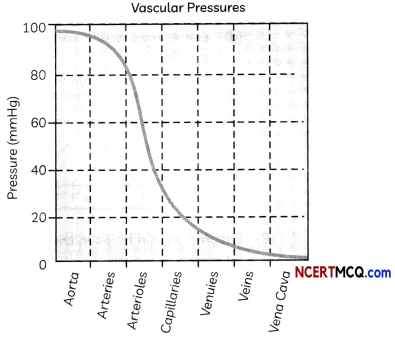
Answer:
![]()
Question 16.
The digestion in stomach is taken care of by the gastric glands present in the wall of the stomach. These release hydrochloric acid, a protein digesting enzyme called pepsin, and mucus. The hydrochloric acid creates an acidic medium which facilitates the action of the enzyme pepsin. The mucus protects the inner lining of the stomach from the action of the acid under normal conditions. From the stomach, the food now enters the small intestine. The food coming from the stomach is acidic and has to be made alkaline for the pancreatic enzymes to act Bile juice from the liver accomplishes this in addition to acting on fats.
(A) In which medium Pepsin and trypsin are active:
(a) basic and acidic medium
(b) acidic and basic medium
(c) neutral medium
(d) sometimes acidic sometimes basic medium
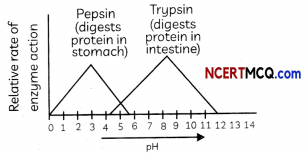
Answer:
(b) acidic and basic medium
Explanation: Pepsin works in the acidic medium and trypsin works in the basic medium to digest the proteins in stomach and in the intestine respectively.
(B) Enzyme pepsin helps in the digestion of:
(a) starch in mouth
(b) protein in stomach
(c) fat in stomach
(d) protein in pancreas
Answer:
(b) protein in stomach
Explanation: Enzyme pepsin helps in the digestion of proteins in the stomach.
(C) The inner lining of the stomach is protected by
(a) enzyme pepsin
(b) mucus
(c) Hydrochloric acid
(d) Muscle
Answer:
(D) Which statement is a valid conclusion based on the information in the graph –
(a) The maximum rate of human digestion occurs at about 45°C.
(b) The maximum rate of human respiration occurs at about 57°C.
(c) Temperature can influence the action of an enzyme.
(d) Growth can be controlled by enzyme
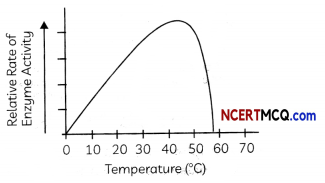
Answer:
(E) Small Intestine receives the secretions from for complete digestion.
(a) Mouth and Stomach
(b) Stomach and liver
(c) Liver and Pancreas
(d) All the above
Answer:
(C) Liver and Pancreas
Explanation: Small Intestine receives the secretions from the liver and pancreas for complete digestion.
Very Short Answer Type Questions
Question 1.
Name an enzyme present in pancreaticjuice.
Answer:
Lipase, Trypsin
Question 2.
If human urine is allowed to stand for sometime, it smells of ammonia, why?
Answer:
Urea present in urine gets decomposed into ammonia by the action of bacteria. So it smells strongly of ammonia.
Related Theory
The purpose of making urine is to filter out waste products from the blood. Nitrogenous waste such as urea or uric acid are removed from blood in the kidneys.
Question 3.
Define parasitic nutrition. Name an organism having parasitic mode of nutrition.
Answer:
![]()
Question 4.
On what factors does the direction of diffusion of carbon dioxide and oxygen depend in plants?
Answer:
The direction of diffusion of carbon dioxide and oxygen in plants depends on the environmental conditions and the requirements of the plant. Carbon dioxide elimination is the major exchange activity at night, whereas oxygen release is the main activity at day time.
Question 5.
What is the role of rings of cartilage present in the throat?
Answer:
The rings of cartilage present ;n the throat ensure that the air passage does not collapse.
Question 6.
What is the role of blood plasma?
Answer:
Question 7.
Why do fishes die when taken out of water?
Answer:
Fishes respire with the help of gills. Gills are richly supplied with blood capillaries and can readily absorb oxygen dissolved in water. Since fishes cannot absorb gaseous oxygen, they die soon after they are taken out of water.
Question 8.
What will happen to a plant if its xyiem is removed?
Answer:
If the xyiem of a plant is removed, the upward movement of water and minerals will stop leading to wilting of leaves and ultimately the death of the plant as xyiem is a water¬conducting tissue in plants. It transports water and minerals from the roots to the different parts of the plant.
Question 9.
The pancreas of a person suddenly stopped functioning. How will digestion be affected in such a person?
Answer: